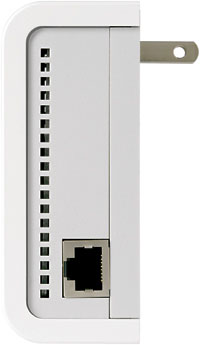This article is more than 1 year old
Netgear HDX101 200Mbps powerline Ethernet adaptor
HD-ready wired networking via your home's power ports
The HDX101 is a little larger than other powerline network adaptors I've seen. As usual, the plug pins are on the back, along with a small sticker detailing the device's serial number and, more importantly, the MAC address. Why can't anyone print these somewhere else so you can read them when the device is plugged in? Netgear's missed a trick here.

Other adaptors place the Ethernet port on the bottom of the device, but Netgear opted to situate it on the left side. This may necessitate some plug juggling to prevent adjacent plugs stopping you from getting the network cable into the adaptor. I doubt it, though, because such is the size of the HDX101 you're probably not going to able to plug anything in next to it, certainly little that's larger than a standard plug.
The device's size arises primarily from the integrated transformer. And in case you're wondering why no powerline adaptor maker includes a pass-through power port, that's one reason. Adding the socket would mean the transformer would have to go elsewhere in the casing, increasing the adaptor's overall size. More to the point, perhaps, every vendor would have to gain further degrees of electrical standards compliance certification, upping the product's cost as well as the size.
The price would also increase if Netgear had opted to fit the HDX101 with a Gigabit Ethernet controller and port. As it stands, the adaptor is equipped with a 10/100Mbps port - fine for a 14Mbps or 85Mbps device like past powerline adaptors, but not, surely, for 200Mbps ones?
Well, yes, because the HDX101 doesn't actually operate at 200Mbps. That's the theoretical maximum speed the technology is capable of. In the real world, once you've suffered signal attenuation on the cabling and wiring, and you've allowed for Ethernet protocol and error-correction codes, the data transfer speed is within the limits of the 100Mbps Ethernet controller. Well, so say makers of powerline Ethernet products. I'm not entirely convinced, but they all ship their 200Mbps products with 100Mbps Ethernet controllers.
In the HDX101s' favour, they're a doddle to connect and get running - they really are plug and play. Netgear helpfully bundles two 1.8m RJ-45 cables, one for each of the devices you'll connect to the two HDX101s. Plug the two devices in and they soon detect each others' presence and begin communicating. Establishing a connection doesn't take place anywhere near as quickly as it does with the Devolo units, I found. Two AVdesks connected in a few seconds; the HDX101s established a link in just under 30 seconds.
You can argue that that doesn't matter if they adaptors are kept continually powered up, but if there's a sudden loss of connectivity because a unit is inadvertently unplugged, or you're of a mind to turn the adaptors off overnight, reconnection speed can be an issue.
